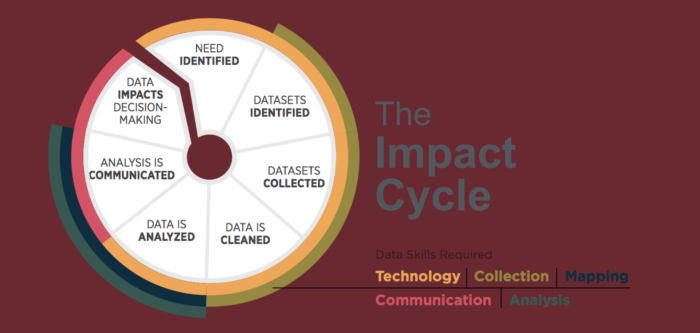Webinar: Increasing open data’s social impact with tactical data engagement
On September 19, we released the official first edition of A Guide to Tactical Data Engagement (TDE), our new resource designed to help city leaders and residents collaborate on increasing the social impact of open government data. As part of our launch, we hosted an online conversation about the new guide and the ideas behind tactical data engagement itself. A recording of the webinar is available on YouTube and embedded below. You can also download a copy of the slide presentation.
What did we talk about? Following is a quick summary.
What is TDE?
Stephen Larrick, Open Cities Director at the Sunlight Foundation kicked off our conversation with an overview of what tactical data engagement is and why cities need to apply it. “Cities are making tremendous progress in providing access to government information online,” Larrick explained. “City halls want to open data to be used, but it often isn’t. And on the flip side, community members want information to be use-able, but it often isn’t.” Our new guide is meant to help bridge that gap, and Larrick provided an overview of this four-step approach: Find a focus area by observing the community; Refine use cases by interviewing stakeholders; Design a plan by coordinating with target users; and Implement an intervention by collaborating with actual users.
Who is using TDE?
The City of Madison, Wisconsin is one of the very first cities to use TDE. Sunlight and our partners at Reboot will be working with Madison on a pilot project over the next several months. The city is currently at the first step of the TDE process. We were honored to have Kara Kratowicz, data projects coordinator at the City of Madison, join the webinar to discuss what that means.
“We began the Finding phase by observing popular meetings and existing public channels,” Kratowicz explained. “The result was to align tactical data engagement with the city’s rewrite of our comprehensive plan. Out of this process, the four preliminary focus areas that we’ve identified are the creation of complete neighborhoods, economic supports, green infrastructure, and public safety.” To further hone their focus area, Madison is planning to poll residents for their feedback about what to prioritize.
How do ‘user personas’ apply?
Once a city has found a focus area and refined it, the third step of TDE is to Design a plan by coordinating with target users. To shed light on this aspect of the process Emily Herrick spoke about Reboot’s work with New York City creating user personas for their open data. “Our goal with the NYC Open Data team was to help them better meet the needs of both existing users as well those who may not be currently using open data,” Herrick explained.
“We identified six different types of users and potential users. We really wanted to reach people outside of the civic tech community – helping them create improvements for their open data initiative that maximize community impact rather than just responding to those who may have the loudest voices.”
As part of their work with New York City, Reboot created a diagram to remind the team about the many different phases of open data impact cycle, keeping different users and use cases in mind.

“We spoke with a woman who runs an affordable housing advocacy organization,” Herrick said. “She’s got some killer instincts about what data she needs, but she’s never really used the open data portal. But she has a great relationship with data analysts and she communicates her needs to them and they go to the portal and analyze that data. So, through this collaborative use case scenario, you can help continue to remind people that people have different desires and needs from open data.”
Implementing TDE
After Finding, Refining, and Designing a plan, the fourth and final step of TDE is to Implement an intervention by collaborating with actual users. April Urban, research associate at Case Western Reserve University’s Center on Urban Poverty and Community Development, spoke about how her organization works with Cleveland communities to solve problems with data, particularly in regard to vacant and abandoned properties in the city.
“Cleveland was hit pretty hard by the foreclosure crisis,” Urban explained, “and this created an environment of people in Cleveland and Cuyahoga County who were interested in understanding data about properties as part of their work to stem this crisis.”
To meet this need, the Center on Urban Poverty team built an application to display property-level data — and then iterated on it.
“We built something very quickly, got it out to users, really embedded ourselves in the community to understand what works, [and] what doesn’t,” Urban said, “and we went quickly to a version two that was more of an extensive re-do. We’ve been on version two for a while, with just some minor changes, and are really starting to see the potential for a version 3 as we get more and more embedded in new community problems.”
Next steps
Thank you to the speakers and everyone who joined the conversation yesterday! You can view the full webinar in the video embedded above and read more in the new TDE guide. If you are interested in tactical data engagement, we want to hear from you: please tell us about your work and your successes, ideas, and questions. We would love to learn what you’re doing or collaborate in the future.

